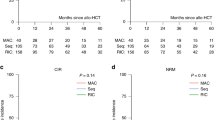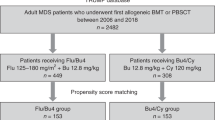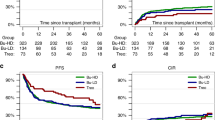Abstract
Myelodysplastic syndromes (MDSs) often occur in older adults with significant comorbidities. Therefore, a reduced-toxicity conditioning regimen may be more suitable than standard conditioning regimens before allogeneic blood stem cell transplantation. Here, we retrospectively compare the outcome of a treosulfan-based conditioning regimen with standard myeloablative TBI-based conditioning regimens in patients (pts) with MDS. A total of 48 pts with MDS were included in the study, of which 29 (60%) pts received TBI-based and 19 (40%) pts received a treosulfan-based conditioning regimen. A significantly lower relapse incidence (5% vs 34% at 3 years, P=0.019) resulting in a better, but not statistically significant relapse-free survival (RFS) (57% vs 31%, P=0.086) was observed after treosulfan-based conditioning. In pts with increased risk for significant side effects due to comorbidities (haematopoietic stem cell transplantation specific comorbidity index), the estimated 3-year RFS was significantly better in the treosulfan group: 54% (95% confidence interval (CI), 17–90%) compared with pts in the TBI group: 11% (95% CI, 0–44%; log-rank test P=0.0455). Treosulfan-based conditioning therapy is a feasible and effective regimen for pts with MDS, especially in pts with preexisting comorbidities.
This is a preview of subscription content, access via your institution
Access options
Subscribe to this journal
Receive 12 print issues and online access
$259.00 per year
only $21.58 per issue
Buy this article
- Purchase on Springer Link
- Instant access to full article PDF
Prices may be subject to local taxes which are calculated during checkout




Similar content being viewed by others
References
Casper J, Knauf W, Kiefer T, Wolff D, Steiner B, Hammer U et al. Treosulfan and fludarabine: a new toxicity-reduced conditioning regimen for allogeneic hematopoietic stem cell transplantation. Blood 2004; 103: 725–731.
Casper JK, Wolff D, Knauf W, Blau IW, Ruutu T, Volin L et al. Allogeneic hematopoietic stem cell transplantation in patients with hematologic malignancies after dose-escalated treosulfan/fludarabine conditioning. J Clin Oncol 2010 (e-pub ahead of print).
Holowiecki J, Giebel S, Wojnar J, Krawczyk-Kulis M, Markiewicz M, Holowiecka-Goral A et al. Treosulfan and fludarabine low-toxicity conditioning for allogeneic haematopoietic stem cell transplantation in chronic myeloid leukaemia. Br J Haematol 2008; 142: 284–292.
Kröger N, Shimoni A, Zabelina T, Schieder H, Panse J, Ayuk F et al. Reduced-toxicity conditioning with treosulfan, fludarabine and ATG as preparative regimen for allogeneic stem cell transplantation (alloSCT) in elderly patients with secondary acute myeloid leukemia (sAML) or myelodysplastic syndrome (MDS). Bone Marrow Transplantation 2006; 37: 339–344.
Schmidt-Hieber M, Blau IW, Trenschel R, Andreesen R, Stuhler G, Einsele H et al. Reduced-toxicity conditioning with fludarabine and treosulfan prior to allogeneic stem cell transplantation in multiple myeloma. Bone Marrow Transplant 2007; 39: 389–396.
Shimoni A, Hardan I, Shem-Tov N, Rand A, Yerushalmi R, Nagler A . Fludarabine and treosulfan: a novel modified myeloablative regimen for allogeneic hematopoietic stem-cell transplantation with effective antileukemia activity in patients with acute myeloid leukemia and myelodysplastic syndromes. Leuk Lymphoma 2007; 48: 2352–2359.
Gropp M, Meier W, Hepp H . Treosulfan as an effective second-line therapy in ovarian cancer. Gynecol Oncol 1998; 71: 94–98.
Gandhi V, Plunkett W . Cellular and clinical pharmacology of fludarabine. Clin Pharmacokinet 2002; 41: 93–103.
Sorror ML, Maris MB, Storer B, Sandmaier BM, Diaconescu R, Flowers C et al. Comparing morbidity and mortality of HLA-matched unrelated donor hematopoietic cell transplantation after nonmyeloablative and myeloablative conditioning: influence of pretransplantation comorbidities. Blood 2004; 104: 961–968.
Sorror ML, Sandmaier BM, Storer BE, Maris MB, Baron F, Maloney DG et al. Comorbidity and disease status based risk stratification of outcomes among patients with acute myeloid leukemia or myelodysplasia receiving allogeneic hematopoietic cell transplantation. J Clin Oncol 2007; 25: 4246–4254.
Glucksberg H, Storb R, Fefer A, Buckner CD, Neiman PE, Clift RA et al. Clinical manifestations of graft-versus-host disease in human recipients of marrow from HL-A-matched sibling donors. Transplantation 1974; 18: 295–304.
Atkinson K, Horowitz MM, Gale RP, Lee MB, Rimm AA, Bortin MM . Consensus among bone marrow transplanters for diagnosis, grading and treatment of chronic graft-versus-host disease. Committee of the International Bone Marrow Transplant Registry. Bone Marrow Transplant 1989; 4: 247–254.
Barrett AJ, Savani BN . Allogeneic stem cell transplantation for myelodysplastic syndrome. Semin Hematol 2008; 5: 49–59.
Laport GG, Sandmaier BM, Storer BE, Scott BL, Stuart MJ, Lange T et al. Reduced-intensity conditioning followed by allogeneic hematopoietic cell transplantation for adult patients with myelodysplastic syndrome and myeloproliferative disorders. Biol Blood Marrow Transplant 2008; 14: 246–255.
Sierra J, Pérez WS, Rozman C, Carreras E, Klein JP, Rizzo JD et al. Bone marrow transplantation from HLA-identical siblings as treatment for myelodysplasia. Blood 2002; 100: 1997–2004.
Lim Z, Brand R, Martino R, van Biezen A, Finke J, Bacigalupo A et al. Allogeneic hematopoietic stem-cell transplantation for patients 50 years or older with myelodysplastic syndromes or secondary acute leukemia. J Clin Oncol 2009; 28: 405–411.
Nemecek ER, Sorror ML, Doney KC, Scott BL, Kovacsovics TJ, Maziarz RT et al. A regimen of treosulfan and fludarabine followed by allogeneic hematopoietic cell transplantation (HCT) for high-risk hematologic malignancies is associated with low treatment-related mortality. Blood 2008; 112: 1029 (ASH Annual Meeting Abstracts 2994).
Beelen DW, Gromke T, Trenschel R, Hilgendorf I, Wolff D, Elmaagacli AH et al. Treosulfan compared to total body irradiation-based preparative regimens before allogeneic stem cell transplantation for acute myeloid leukemia: a retrospective long-term study. Blood 2008; 112: 748 (ASH Annual Meeting Abstracts 2149).
Ruutu T, Beelen DW, Finke J, Holowiecki J, Uharek L, Kienast J et al. Reduced-toxicity conditioning with treosulfan and fludarabine in allogeneic haematopoietic stem cell transplantation for myelodysplastic syndromes: final results of an international prospective phase II trial. Bone Marrow Transplantation 2009; 43: 556 (Suppl 1) (abstract O300).
Valcárcel D, Martino R, Caballero D, Martin J, Ferra C, Nieto JB et al. Sustained remissions of high-risk acute myeloid leukemia and myelodysplastic syndrome after reduced-intensity conditioning allogeneic hematopoietic transplantation: chronic graft-versus-host disease is the strongest factor improving survival. J Clin Oncol 2008; 26: 577–584.
Author information
Authors and Affiliations
Corresponding author
Ethics declarations
Competing interests
U Pichlmeier is an employee of medac GmbH.
Rights and permissions
About this article
Cite this article
Hilgendorf, I., Wolff, D., Gromke, T. et al. Retrospective analysis of treosulfan-based conditioning in comparison with standard conditioning in patients with myelodysplastic syndrome. Bone Marrow Transplant 46, 502–509 (2011). https://doi.org/10.1038/bmt.2010.153
Received:
Revised:
Accepted:
Published:
Issue Date:
DOI: https://doi.org/10.1038/bmt.2010.153
Keywords
This article is cited by
-
Conditioning with fludarabine and treosulfan compared to FLAMSA-RIC in allogeneic stem cell transplantation for myeloid malignancies: a retrospective single-center analysis
Annals of Hematology (2022)
-
Combination of treosulfan, fludarabine and cytarabine as conditioning in patients with acute myeloid leukemia, myelodysplastic syndrome and myeloproliferative neoplasms
Journal of Cancer Research and Clinical Oncology (2021)
-
Fludarabine and treosulfan compared with other reduced-intensity conditioning regimens for allogeneic stem cell transplantation in patients with lymphoid malignancies
Bone Marrow Transplantation (2015)
-
Treosulfan-based conditioning regimens for allogeneic HSCT in children with acute lymphoblastic leukaemia
Annals of Hematology (2015)
-
Long-term follow-up of children conditioned with Treosulfan: German and Austrian experience
Bone Marrow Transplantation (2013)



